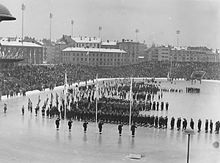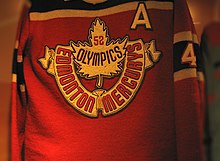1952 Winter Olympics
Instead, Oslo won the right to host the 1952 Games in a contest that included Cortina d'Ampezzo in Italy and Lake Placid in the United States.
All of the Olympic venues were in Oslo's metropolitan area, except for the alpine skiing events, which were held at Norefjell, 113 km (70 mi) from the capital.
[1] Japan and Germany made their returns to Winter Olympic competition after being forced to miss the 1948 Games in the aftermath of World War II.
Portugal and New Zealand made their Winter Olympic debuts, and women were allowed to compete in cross-country skiing for the first time.
Norwegian truck driver Hjalmar Andersen won three out of four speed skating events to become the most decorated athlete of the 1952 Winter Olympics.
Dick Button of the United States performed the first triple jump in international competition to claim his second consecutive men's figure skating Olympic title.
[5] But the organizers believed the 1952 Games could be an opportunity to promote national unity and to show the world that Norway had recovered from the war.
[6] Vying with Oslo for the right to host the Games were Cortina d'Ampezzo, Italy, and Lake Placid, New York, United States.
[1] A special committee was assigned to organize the 1952 Games, which consisted of four Norwegian sports officials and four representatives from the municipality of Oslo, including mayor Brynjulf Bull.
[11] The city of Oslo paid to have a new hotel constructed, the Viking, used for IOC delegates, out-of-town dignitaries, and as the communication hub of the Games.
[14][15] Oslo's existing central arena, Bislett Stadium, was used for the opening and closing ceremonies, and for speed skating events.
Improvements to the arena included better sound and lighting systems, remodeled club house and press rooms, and the addition of a medical center.
[16] In the aftermath of the German occupation of Norway during World War II, anti-German sentiment began to affect preparations for the 1952 Olympics.
[18] When in 1950, the West German Olympic Committee requested recognition by the IOC, it raised the question of whether their participation would cause political boycotts in the upcoming Games.
[14] King George VI of Great Britain had died on 6 February 1952 with his daughter Elizabeth II taking the throne as Queen, eight days before the start of the Games.
[24] As a result, all national flags were flown at half-mast, and Princess Ragnhild opened the Games in place of her grandfather, King Haakon VII, who was in London attending the state funeral.
[26] The British, Australian, Canadian and New Zealand teams all wore black arm bands at the opening ceremonies in memory of their monarch.
[30] After a 16-year hiatus from the Olympics, Germany made a triumphant return to the bobsleigh competition, winning the two- and four-man events.
[31] Seeing the undue advantage overweight athletes brought to their teams, the International Federation for Bobsleigh and Toboganning instituted a weight limit for future Olympics.
[34] Americans Ken Henry and Don McDermott placed first and second in the 500-meter race, but Norwegian truck driver Hjalmar Andersen electrified the partisan crowd by winning the 1,500, 5,000 and 10,000-meter events;[34][35] his margins of victory were the largest in Olympic history.
The Hungarian-born speed skater had won both long-distance races at the World Championships held in Oslo in 1949 and then defected to Sweden,[34] but was unable to obtain Swedish citizenship in time to compete in 1952.
[37] Austrian skiers dominated the competition, winning seven out of a possible 18 medals, including Othmar Schneider who won gold and silver in the men's slalom and downhill.
[42] Lydia Wideman of Finland became the first female Olympic champion in cross-country skiing; her teammates Mirja Hietamies and Siiri Rantanen won silver and bronze respectively.
[48] The Norwegian athletes did not disappoint the crowd, as Arnfinn Bergmann and Torbjørn Falkanger placed first and second; Swedish jumper Karl Holmström took the bronze.
[58] They defeated Americans Karol and Peter Kennedy, who placed second,[59] and Hungarian siblings Marianna and László Nagy, who won the bronze medal.
[62] Canada had won all but one Olympic hockey tournament thus far, but in 1956 the Soviet team began to compete and ended Canadian dominance.
[62] The Czechs believed they had already won the bronze when they defeated the Swedes in the round-robin, calling the decision to play a tie-breaking game a "plot of the capitalist countries".
[66] Popular in Nordic countries, bandy is played by teams of eleven on an outdoor soccer field-sized ice rink, using a small ball and sticks about 1.2 m (3.9 ft) long.
[14] A new stadium was built for the hockey tournament in a residential area of eastern Oslo, called Jordal Amfi, which accommodated 10,000 spectators in stands rising steeply from the rink.
The downhill race and the giant slalom—which made its Olympic debut in 1952—were held at Norefjell, which was 113 km (70 mi) from Oslo and the only venue located away from the capital city.





